 Technology
Technology  Technology
Technology  Humans
Humans 10 Everyday Human Behaviors That Are Actually Survival Instincts
 Animals
Animals 10 Animals That Humiliated and Harmed Historical Leaders
 History
History 10 Most Influential Protests in Modern History
 Creepy
Creepy 10 More Representations of Death from Myth, Legend, and Folktale
 Technology
Technology 10 Scientific Breakthroughs of 2025 That’ll Change Everything
 Our World
Our World 10 Ways Icelandic Culture Makes Other Countries Look Boring
 Misconceptions
Misconceptions 10 Common Misconceptions About the Victorian Era
 Mysteries
Mysteries 10 Strange Unexplained Mysteries of 2025
 Miscellaneous
Miscellaneous 10 of History’s Most Bell-Ringing Finishing Moves
 Technology
Technology Top 10 Everyday Tech Buzzwords That Hide a Darker Past
 Humans
Humans 10 Everyday Human Behaviors That Are Actually Survival Instincts
 Animals
Animals 10 Animals That Humiliated and Harmed Historical Leaders
Who's Behind Listverse?

Jamie Frater
Head Editor
Jamie founded Listverse due to an insatiable desire to share fascinating, obscure, and bizarre facts. He has been a guest speaker on numerous national radio and television stations and is a five time published author.
More About Us History
History 10 Most Influential Protests in Modern History
 Creepy
Creepy 10 More Representations of Death from Myth, Legend, and Folktale
 Technology
Technology 10 Scientific Breakthroughs of 2025 That’ll Change Everything
 Our World
Our World 10 Ways Icelandic Culture Makes Other Countries Look Boring
 Misconceptions
Misconceptions 10 Common Misconceptions About the Victorian Era
 Mysteries
Mysteries 10 Strange Unexplained Mysteries of 2025
 Miscellaneous
Miscellaneous 10 of History’s Most Bell-Ringing Finishing Moves
10 Myths And Misconceptions About World War I
In the public consciousness, World War I has often played second fiddle to its psychotic offspring. The fascination with World War II has its own problems, but at the very least people are more aware of the facts and more inclined to investigate the origins of those facts. This is not the case with the First World War, and it has had the unfortunate consequence of solidifying myths and misconceptions as truth.
10The Lusitania
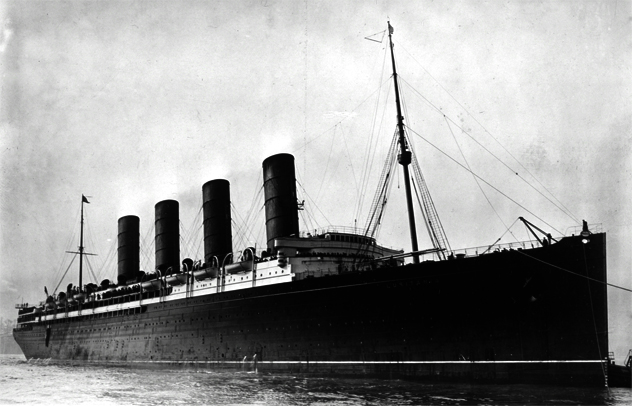
The whole of this article could be over misconceptions and arguments about the origins of the First World War, but then it would be several thousand pages long. Seriously, the controversies over who or what caused the war have spilled more ink than the actual war spilled blood. Fortunately, for this article, there is a rather simple (relative to Europe’s story, of course) misconception about the origin of America’s entry into the conflict: the Lusitania.
On May 7, 1915, a German U-boat sank a British cruise liner named the Lusitania that was carrying American passengers. There was public outrage at the atrocious crime committed against civilians by the evil Hun, and the Wilson administration quickly translated that outrage into troops in the trenches. Or so the story goes. But, as you’ve probably deduced, it’s not entirely accurate.
First, let’s unpack what actually happened with the Lusitania. It was a British ocean liner, and it also happened to be holding war munitions. These materials, which the Germans suspected the ship to be carrying, broke the “Cruiser Rules”—the ship ceased to be simply a passenger ship or a merchant ship once it began carrying combat weaponry. Next, the Germans went to great lengths to warn Americans of the danger of ocean travel for British ships en route to Europe. They even took out full-page ads in 50 American newspapers warning that the war zone included the waters surrounding the British Isles. Lastly, the captain of the ship steered wantonly and flagrantly in the face of danger. He drove close to shore in places filled with U-boats, he sailed slowly, and he did not zigzag. It is no wonder they were hit with a torpedo. A massive 1,198 people died, 128 of whom were American.
Next, let’s examine the actual reason that America entered the war. When Woodrow Wilson went before Congress to give his reasons for war, he cited two issues. One was the Zimmermann Telegram, with which the Germans attempted to enlist Mexico in the war against the US. The second was Germany’s broken promise to suspend unrestricted submarine warfare. You may be saying, “Uh, I thought you said this wasn’t about the Lusitania,” and it isn’t. In 1916, Germany had sunk a French boat named the Sussex. Wilson made the Germans promise to stop sinking ships with civilians, which became known as the Sussex Pledge. Germany, however, decided to violate the pledge in 1917 because they believed they could win the war before America entered. Thus on January 31, 1917, the German ambassador presented the US with a note stating that they would resume their program of unrestricted warfare. These are the actual reasons America entered the First World War.
9Trenches
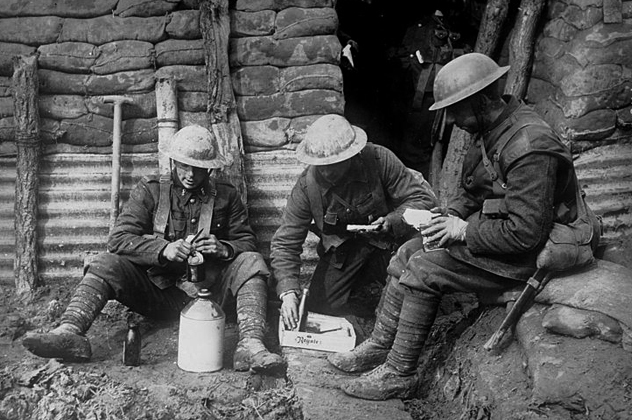
The common perception of the trenches is that the soldiers lived a material nightmare for months on end. It is true that the trenches could be the seventh circle of Hell filled with near-constant bombardment and the crushing uncertainty of imminent death, but 9 out of 10 soldiers who went in came out alive. Much of their time was devoted to chores and preparation rather than actual fighting or “going over the top.” Some days, the only action some troops would see was during a routine called “morning hate.” Before breakfast, men would line up to wake the enemy, just to keep them on their toes. Then, after only a few days, men would be rotated out of the “fire-line” trenches (the trenches that actually saw battle). Rarely would any man be kept in the trenches for more than five days. Of course, those five days could still feel like a lifetime.
There was also great variety to the different national trenches. The Germans, for instance, created elaborate and sophisticated systems with electricity, beds, toilets, and other creature comforts. Some of the trenches went 15 meters (50 ft) deep, and they could be relative paradises compared to the muddy, open-air hovels of their enemies.
8Kitchener’s Army And Uncle Sam
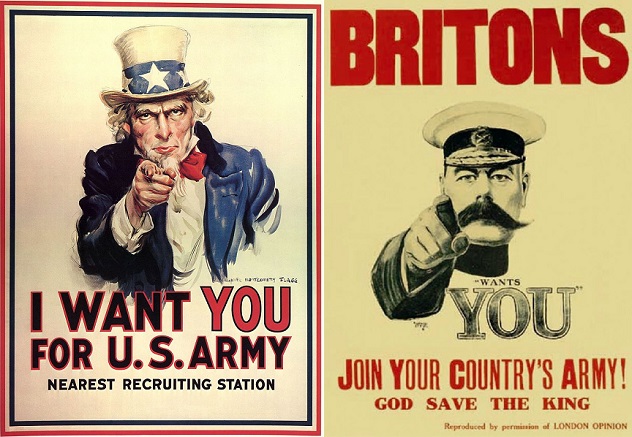
It might come as a shock to some American readers that the American poster on the left above isn’t quite so American, and that it was not invented for World War II. Credit for the inspiration of the iconic propaganda poster actually goes to the British (on the right above).
Some of you may know this story already. If so, you probably know that the man in the poster is Lord Kitchener and that the young men who signed up as a result were called “Lord Kitchener’s army.” The only problem is, the poster wasn’t used during the First World War.
New research by historian James Taylor has revealed that the famous image created by graphic artist Alfred Leete only gained popularity after the war, similar to the recent ubiquity of the World War II propaganda posters urging Britons to “Keep Calm and Carry On” during the Blitz. He claims that it was only used as a magazine cover in 1914, and then sold as a postcard (although not a single one has been tracked down, and there is a £100 reward for anyone who can produce one). There were other posters featuring Kitchener, and Taylor further contends that the existing Kitchener posters were no more popular than other similar propaganda posters of the time. The collective misremembering is attributed to the Imperial War Museum mistakenly cataloging the original artwork as a poster in 1917.
7The Cult Of Hitler
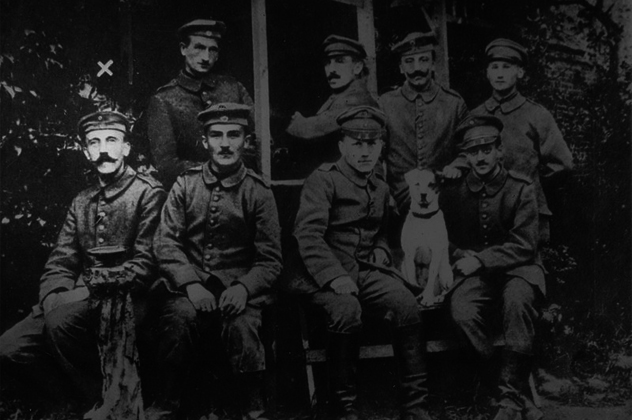
There is a pervasive belief that Hitler was a daring hero during the First World War. The History channel, in their World Wars documentary, most recently propagated this myth. It portrayed Hitler as a brave soldier firing from the front lines of the trenches. Later that night, they showed Hitler stoically staring into a mirror before taking a bayonet and shaving his facial hair into the infamous mustache. I’m assuming that their source material was Mein Kampf. Otherwise, I’m not sure where they got their material.
In reality, he was not even a proper soldier—he was a message runner. It is true that battalion runners were deep in the trenches running across the front line, but Hitler was a regimental runner. For the vast majority of the war, he was stationed about 1.6 kilometers (1 mi) behind the front, where he had a nice bed above ground and a real roof. His fellow soldiers referred to him as a “rear area pig.” He rarely even saw gunfire (although he was wounded twice during the few times he was near an attack).
It is true that he did receive medals for his service, but they were not for valor or bravery. The first one was an Iron Cross Second Class—a common award—and the second was the Iron Cross First Class. Much ado has been made about the First Class (a much rarer award), but Hitler received it because of his cozy familiarity with senior officers, and it was already an award given more frequently to regimental runners than to combat soldiers.
6It Was The Deadliest War Up Until That Time
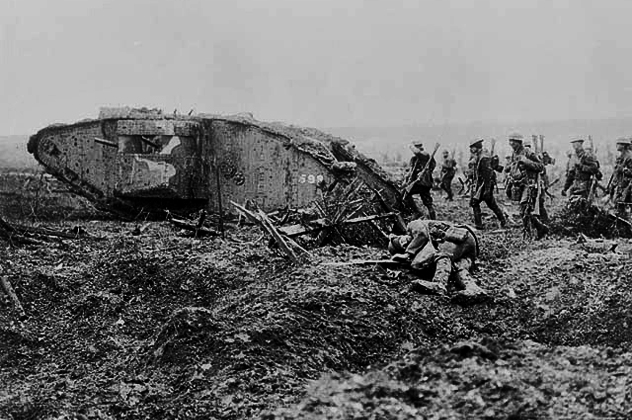
We are strictly speaking war here, and not centuries-long conflicts like the Mongol conquests. Many people think that World War I was the second deadliest war of all time, and that it was the deadliest war until World War II. It is an easy, logical step to make: World War II is the deadliest war, ergo World War I is the second deadliest. There is one conflict, however, that places itself squarely between the two in terms of lives taken. It was the massive Chinese civil war known as the Taiping Rebellion.
Estimating the death toll of any war is never an exact science, and the high-end and low-end numbers can vary by tens of millions. We will be conservative and use the low-end estimates. The low estimates for the First World War are roughly nine million. The low estimates for the Taiping Rebellion are about 20 million.
Two things must be noted, though. First, the numbers for the Taiping Rebellion are much less accurate than the numbers for World War I (although it is still generally considered to be a deadlier war). Next, the deaths of the Taiping Rebellion are largely due to siege warfare and famine being used as a tactic in densely populated Chinese cities, along with the bizarre nature of the war itself: A leader named Hong Xiuquan believed himself to be the son of God, and he wanted to bring the wrath of the vengeful Old Testament God to China. Taiping zealotry led to insane instances of high death counts, like after the capture of Nanking when 100,000 soldiers chose death over capture.
5The British Aristocracy And Upper Classes Did Not Suffer
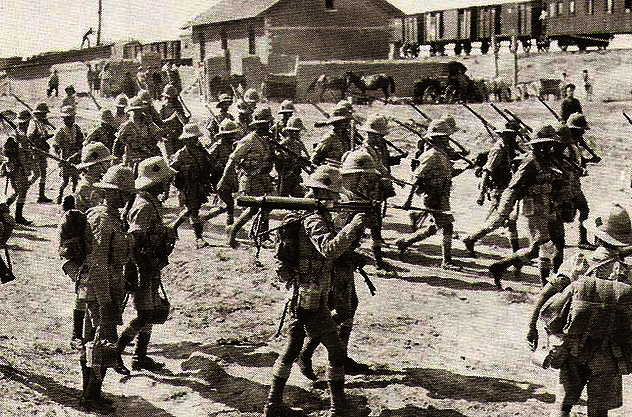
This myth might be the most straightforward untruth: the idea that the rich and privileged, the men who largely composed the officer corps, went through the war largely unscathed. The truth is almost the complete opposite, and it would not be entirely disingenuous to characterize the war as the war of the aristocracy and the well-to-do. It was the elites who sleepwalked Albion into war, and it was they who had to prove that the old order was worth protecting. After all, what is Britain other than tradition, the country without a written constitution?
It is true that more middle- and lower-class soldiers died, but there simply were more middle- and lower-class people. If you look at percentages, the numbers tell a shocking story. For the entirety of mobilized men, the death rate was about 12 percent, but for graduates of Oxford and the aristocracy, it was 19 percent. If you look just at the elite boarding schools, it jumps to 20 percent. That is one in five deaths of an already tiny sliver of a population. As The Atlantic puts it, “Not since the Wars of the Roses has the aristocracy suffered such loses.”
4Germany Did Not Reach Either Paris Or London
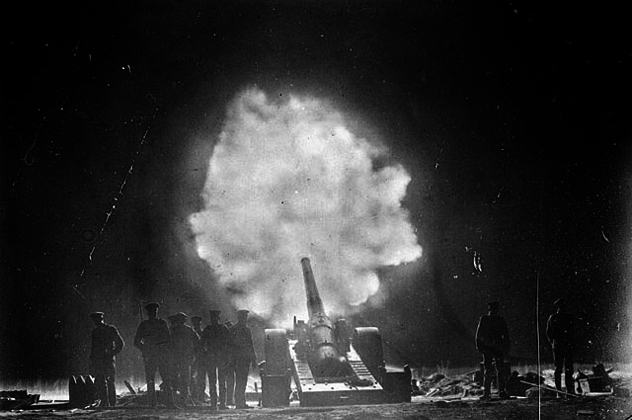
Most people think of the Western Front as a stalemate after the initial months of hostilities, and that Germany had been effectively stopped outside Paris. It is mostly true that the belligerent nations fought bitterly for only a few miles at a time for the majority of the war, but Germany was always willing to get creative for big gains. Due to their creativity and embrace of technology, Germany was able to directly attack both Paris and London.
The Germans subjected Paris to a cutting-edge weapon known as the “Paris Gun.” It was a monstrosity. The cannon was nearly 35 meters (115 ft) long, and it had a range of roughly 129 kilometers (80 mi). The range meant that it could safely sit behind German lines while raining bombs down on Paris—or at least, that was the idea. In reality, the gun was not very accurate, but it was able to kill hundreds of Parisians. The worst incident happened when a shell hit a church during a service for Good Friday, killing or maiming most inside. The gun’s greatest success was psychological. The French lived in fear of a weapon they knew nothing about, a weapon that could kill them at any time and that they had no defense against.
In London, the Germans carried out bombing raids with Zeppelins. Yes, aerial warfare was more than the fanciful stories of ace pilots shooting each other with pistols as they tried to pilot their newfangled technology. In fact, that brings us to our next myth . . .
3Aerial Warfare
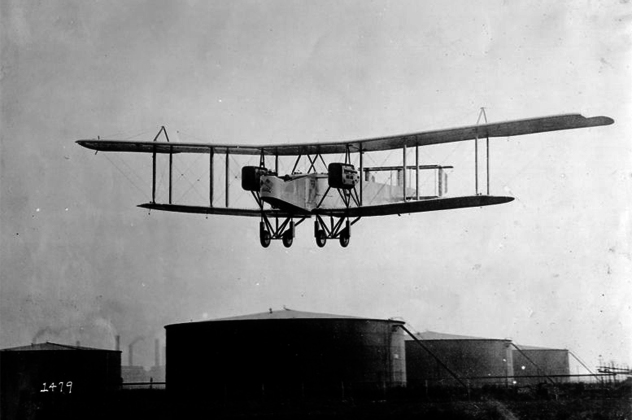
Most people think that aerial warfare took place for the first time during the First World War. This is not true even if you limit the definition of “aerial warfare” to airplanes. The Wright brothers’ first powered flight took place on December 17, 1903, and it lasted a mere 12 seconds. Less than eight years later, the airplane would make its debut as a military weapon. During the Italo-Turkish War of 1911 (fought in Libya), an Italian pilot named Carlo Piazza bombed enemy positions on November 1. It would be used again in the Balkan Wars the following year as the plane’s martial ability improved. But aerial warfare has a much longer history. The first time the sky was utilized for more than reconnaissance was in 1849.
The Republic of San Marco was an Italian revolutionary state that had declared independence from the Austrian Empire in 1848 (a year known to history as the “Springtime for Revolution”). The Austrians did not take kindly to this, and launched a war to retake their territory. They were quite successful, and by 1849 they were laying siege to Venice, the capital of San Marco. An Austrian artillery officer named Franz von Uchatius devised balloons that could be launched from naval decks and armed with one bomb each. Numbers vary as to how many were launched, how many bombs fell, and if it was a successful mission, but one thing is certain: Bombs fell from the sky that day.
2Chemical Warfare
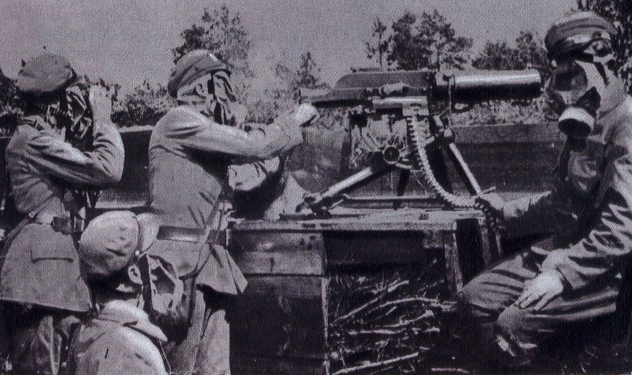
The First World War will forever be associated with the horrors of chemical warfare. Chlorine gas was used first, followed by mustard gas. Both caused enormously protracted and painful deaths. Many think that chemical gas was invented to break the stalemate on the Western Front. It was used as one tactic to get the offensive war rolling once more, but it was not invented for World War I. Since humans are so wonderful, we have a long and rich history of chemical warfare.
Chemical warfare, specifically gas warfare, dates back to ancient times. The Persians burned bitumen and sulfur to asphyxiate a group of Roman soldiers trying to tunnel into their garrison. The ancient Chinese employed their own version of “mustard gas” against an enemy—they burned mustard to produce arsenic trioxide smoke and billowed it onto their rivals.
Early modern times saw the invention of projectiles filled with poisonous gasses. Incendiary shells would be filled with sulfur, tallow, and resin so that the resulting fires would create deadly smoke. By 1675, chemical-laced projectiles had become such a problem that the warring nations of the time signed their own Geneva Convention of sorts, a treaty called the Strasbourg Agreement.
1The First World War
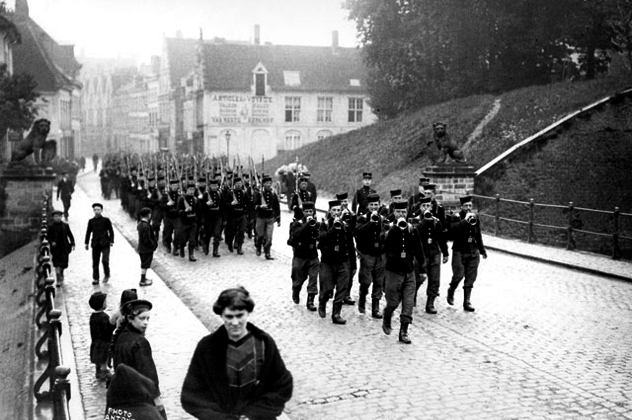
This last myth is a bit complicated: The First World War was not the first world war. The first problem is figuring out what a world war is. Then you have to ask if it fits the criteria (and, for World War I, whether it was the first time a war met that criteria). Next, you need to figure out if it’s always been called that, and, if not, why the accepted vernacular changed. This is all compounded further by problems like figuring out who first said it and why it then became accepted as true.
The term “world war” predates what we now call World War I by a number of years and appears in English by at least 1898. It was a term that existed on its own and was not tied to any specific war. Next is the question of whether World War I was always referred to by that name. But of course, it wasn’t—there are some instances of people referring to it as a world war, but the public at large mainly called it the “Great War,” the “European war,” or the “War to End All Wars.” To any astute naysayers, it is true that as early as 1914 the Indianapolis Star and the Pittsburgh Press referred to it as the First World War, but it isn’t until 1920 that we see another reference. These instances were outliers to what the average person would simply call “the war.” It really wasn’t until FDR referred to the “Second World War” that the idea of World War I and World War II gained popularity. So World War I being the first world war is not due to reliable historicity—it’s just a convenient way to divide up two inextricably linked wars.
In fact, there were many “world wars” before World War I: the Napoleonic War and The Crimean War, to name a few. But, you may be saying, World War I was still the “largest” and that’s what people mean when they say the First World War. But that’s not true, either—both the Napoleonic Wars and the Seven Years War were fought over a “larger” scale. In terms of life lost there were several Asian conflicts that surpassed the death toll of 1914–1918, as already stated. So which is the first world war? I tend to agree with Winston Churchill that the moniker “the first world war” should go to the Seven Years War. That war was the first to involve all major players on all major continents, instead of just Europeans fighting each other. Americans may recognize the Seven Years War by its alternative name: the French and Indian War.
I should note, however, that I am not advocating people to begin referring to the Seven Years War as World War I, but rather to point out that history is not a precise science. Concepts, classifications, and ideas often arise organically without definite structure. Not to mention that World War I does possess qualities that make it the first of its kind, if not the first “world war.” It’s also just easier to say “the First World War” rather than a headache of a name with a laundry list of specific qualifiers.
I am a graduate student studying the First World War, and in my free time I like to write about things. You should follow me on Twitter because in this day and age if you ever want to do this full time you need followers. Also, I occasionally make jokes. Bad jokes, but jokes nonetheless.








